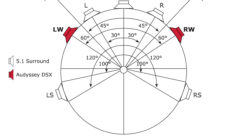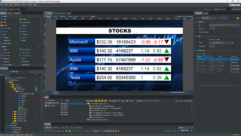
The Buzz: Installation Spotlight: Commemorative Solutions
Mar 1, 2009 12:00 PM,
By Trevor Boyer
Rock and Roll Hall of Fame Annex, New York

The Rock and Roll Hall of Fame Annex in New York is the first high-profile installation in the United States to use the Sennheiser GuidePort system. Museum visitors don headphones and one of 600 iPod-like GPEK3202 4-1 GuidePort receivers to control the exhibit audio. To generate audio-track switching commands, there are 12 defined audio zones with inductive-loop antennas buried under the carpeting.
The newly opened Rock and Roll Hall of Fame Annex certainly has a New York flavor. Located in New York’s SoHo neighborhood, it’s mere blocks from long-gone downtown nightspots that showcased the New York rock scene during its late-’70s/early-’80s heyday. These locales are given their due at the facility on a topographical model of Manhattan that’s the length of some studio apartments. Like New York, the annex is fairly cramped, which proved to be a great challenge for integration firm Acme Professional — based in New Market, Md., with an office in New York.
In late 2006, the well-established Broadway sound-design firm Acme Sound Partners spun off its Acme Professional integration wing, led by veteran installer Pete Cosmos. The parent firm had worked with Running Subway Productions on the theatrical version of How the Grinch Stole Christmas. The Cleveland-based Rock and Roll Hall of Fame teamed with Running Subway to produce the annex attraction in New York, and Running Subway suggested Acme as the systems integrator for the audio, video, lighting, and control portions of the attraction — which opened late last year.
Acme principal Tom Clark explains that the people at the main Hall of Fame in Cleveland were heavily involved in the process of designing the New York annex, from helping secure rights to recorded music to setting guidelines for how artifacts were to be protected. Music is the raison d’être of the museum annex, and the Cleveland team did not want the central attraction to blast through a cacophonous series of loudspeakers.
“They clearly wanted to be able to honor the music, and the only way they could imagine doing that was to make it a private affair,” Clark says. “And they were also trying to make the process of going through the museum, for the visitor, as organic as possible.”
GUIDEPORT SOLUTION
That meant visitors wouldn’t be punching in a three-digit number to hear an audio track associated with an artifact. Striking such standard options, Acme needed another solution that would play music automatically and privately. The firm thus turned to Sennheiser’s GuidePort system, making the museum the first high-profile installation in the United States to make use of the GuidePort system, according to Sennheiser. Using GuidePort, visitors don headphones and an iPod-like device with simple control buttons. The annex has 600 GPEK3202-4-1 GuidePort receivers.
The tight confines of the space became the main challenge for Acme as it attempted to define discrete zones that would trigger audio playback on the GuidePort devices.
“The exhibits are quite close together at the annex, and the system has physical requirements about proximity of trigger zones,” Clark says. “We did quite a lot of experimentation early to precisely predict how the trigger mechanisms were going to work on our ground plan.”
The Buzz: Installation Spotlight: Commemorative Solutions
Mar 1, 2009 12:00 PM,
By Trevor Boyer
Rock and Roll Hall of Fame Annex, New York
Last July, once the remnants of the space’s previous tenants were cleared, Acme built a full-scale plywood model of the annex’s layout.
“We laid out the entire GuidePort system long before the construction was finished, so that we could test its capabilities in real space,” Clark says.
Related Links

Installation Profile: Intelligent Design
Founded in 1853, the California Academy of Sciences (CAS) is one of the cultural jewels of the San Francisco area. It houses an aquarium, a natural history…

The Aurora Multimedia Dido Jr. allows for the creation of truly spectacular high-quality, realtime videowalls that require a minimum of technical expertise…

It had an AV budget that few museums can command a healthy percentage of the project’s $450 million budget, consumed by hundreds of loudspeakers and screens,…
The attraction contains 32 “events.” Each GuidePort unit stores 512MB of data, and for the annex, that storage space holds 20 audio files. When a visitor walks into an audio zone that is not associated with synchronized video, a stored track on the GuidePort automatically plays back from its beginning.
“In essence, you have the equivalent of a high-quality MP3 player,” Clark says. “There is some compression involved, but it’s much closer to CD quality than MP3.”
Keeping on-demand, nonsynchronized audio out of the venue’s airwaves clears FM-frequency headroom for the video events that do require synchronization with audio. When visitors step into one of these 12 areas on the floor, his or her GuidePort picks up a constantly playing audio channel via an FM radio frequency. Five GuidePort transmitters send these synchronized audio channels to the visitors’ receivers.
AUDIO AND VIDEO
To generate audio-track switching commands, Acme painstakingly defined audio zones by burying inductive-loop antennas under the carpeting.
“You can think of it as sort of a force field that is defined by the shape of the antenna loop,” Clark says. “The energy emanates from the antenna wire itself in a slightly cone-shaped direction.”
For the antenna loops, Acme used flatwire — about half the thickness of a credit card and used primarily in home-entertainment systems. Antennas are connected to devices called “identifiers,” which send out a pulse to the GuidePort receiver to switch the channel. Acme reduced the power of these pulses to tighten the trigger zones. Acme followed the plan of exhibit designer Patrick Fahey of Eight Hands High (New York) as closely as possible, but it made adjustments to the layout to separate the zones better and keep the system working cleanly.
On a recent visit to the annex, this reporter found that occasional interference between the zones was a problem. For instance, I would be watching the Rolling Stones but hearing the Grateful Dead. However, I could easily and quickly situate myself better on the floor to pick up the proper associated song. This seemed like a reasonable amount of effort considering the price of admission is not cheap ($26) and the museum is packed with artifacts. Visitors are therefore going to want to stay for at least a couple of hours. Clark admits that the triggering system is not perfect, and he says his company has tweaked the zones since the museum’s opening.
But for him, the trade-off of including more music was worth it. “It was more important to us to have as many audio sources as possible than it was to have them be impossible to fool,” he says.
Throughout the museum are 32in. and 40in. Sony LCD flatscreens (models FWD40LX2F/B and FWD32LX2F/B) and 4000-lumen Sony VPL-FE40LCD projectors. A single-channelAdtec Digital edje 4111 HD box feeds each screen an MPEG file. Keeping the edje boxes close to the displays helped Acme optimize the video quality and made it possible to use Cat-5 cable to wire most of the facility. The venue’s all-encompassing Medialon show-control system controls the network-addressable Adtec players.
The Buzz: Installation Spotlight: Commemorative Solutions
Mar 1, 2009 12:00 PM,
By Trevor Boyer
Rock and Roll Hall of Fame Annex, New York
The Medialon system also addresses Dataton Watchout, the software that drives a theater program that welcomes visitors. Visitors watch an 11-minute history of rock and roll unfold on seven displays — brightened by three 7000-lumen Sony VPL-FW300L projectors and four VPL-FE40 units — and hear it in 5.1 surround at about 100dB. Batwin + Robin Productions of New York devised the video presentation, and Acme created the multichannel mix for the show, which relies almost completely on concert footage that was recorded in stereo and, in some cases, mono. Available Light of New York created the lighting design for the show and the annex’s exhibits.
For the exhibit and theater loudspeakers, Acme turned to Klein + Hummel. (Sony and Sennheiser provided equipment to the annex via a sponsorship arrangement.) The theater system comprises four LCR 12in. IS 123 X54B two-way mains, six 6in. Pro X 6 N two-way surrounds, and two 12in.Pro X Sub L subwoofers.








